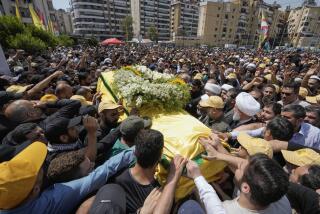Antiquities Loss Estimates Called ‘Gross Exaggeration’
Iraqi estimates of looting from the Iraq Museum here were “a gross exaggeration,” the head of a 14-member U.S. investigative team said Friday as he delivered a preliminary report on the thefts.
U.S. Marine Reservist Col. Matthew F. Bogdanos conceded that his findings were based in large part on assumptions. He noted that contents of two underground vaults at the Iraqi Central Bank where many antiquities were placed for safe-keeping have yet to be opened, and museum inventories have yet to be verified.
“The investigation also uncovered the existence of a secret storage location used since 1990,” Bogdanos told reporters, referring to the year in which Iraq invaded Kuwait. “Museum officials admit several members of their staff know of its existence but are sworn to secrecy not to divulge its location until a new government in Iraq is established and U.S. forces leave the country.”
Bogdanos, who in civilian life is a prosecutor in New York, said almost 1,000 stolen items have been returned to the museum and one of the world’s most precious coin collections has been recovered intact.
Bogdanos used his team’s preliminary findings to dispute persistent allegations that U.S. forces failed to protect priceless items in the museum -- some dating from the glory of ancient Babylon -- while taking pains to safeguard hundreds of facilities for Iraq’s vast oil industry.
Donny George, Iraq’s head of research and artifacts at the State Board of Antiquities, stood beside Bogdanos at the news conference outside the museum, evading questions about his earlier criticism of U.S. military inaction.
“I don’t think it is the time to again and again open that wound,” George said. “Now is the time to work together to recover what was stolen .... There is no one to blame now.”
George praised Bogdanos’ investigators and appeared to agree with their initial findings that at least some of the thefts were inside jobs by museum staffers.
Bogdanos said the thieves fell into three categories: “individuals who knew what they were stealing, aided or not by employees,” others “who clearly must have had an intimate knowledge of the museum” and “indiscriminate looters.”
He based those conclusions on his team’s previously reported finding that thieves stole “the most trafficable and easily transportable items stored in the most remote corner of the museum.”
Among the items still missing, he said, were 33 of the 42 pieces originally reported stolen from the museum’s public galleries, “most notably the Sacred Vase of Warca dating from 3000 BC and the Bassetki Statue. Fifteen other pieces were damaged, notably the Golden Harp of Ur, although its golden head had previously been removed to the bank vault.”
Bogdanos vowed that U.S. investigators will attempt to track down the items with the aid of Interpol, the FBI and other police agencies by targeting known international art smugglers and buyers. They also would begin a second phase of the investigation, focusing on the employees of the museum, which, he said, was tightly controlled by Saddam Hussein’s Baath Party.
Bogdanos could not say why the underground vaults at the heavily bombed Central Bank had not been opened. According to his four-page report, over the last 13 years the museum staff transferred 15 to 20 boxes of gold and jewelry, including treasure from the ancient Assyrian city of Nimrud, to the vaults.
“To date, the museum staff has produced partial inventories for those items. Because those vaults are still sealed, the team has not yet been able to verify the accuracy of the inventories,” the report said.
Bogdanos suggested that accessing those vaults was beyond his authority.
“It’s not a decision that an investigator is going to make,” he said. “All I can tell you is, it will be done. And when it is, we’re going to have someone there confirming or denying the accuracy of these inventories.”
Among the investigators’ biggest challenges, Bogdanos said, was the museum’s loose record-keeping system. The team also struggled with the museum’s perceived ties to the Baath Party.
He described one museum cache that his investigators did manage to find -- boxes of priceless books and manuscripts stored in a bomb shelter. After community leaders told his team that they didn’t want to return the items to a Baathist institution, Bogdanos said investigators “agreed to leave them locked in the shelter, protected by a 24-hour neighborhood watch.”
More to Read
Sign up for Essential California
The most important California stories and recommendations in your inbox every morning.
You may occasionally receive promotional content from the Los Angeles Times.










